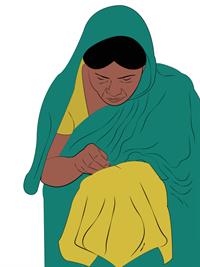
PUMPA - SMART LEARNING
எங்கள் ஆசிரியர்களுடன் 1-ஆன்-1 ஆலோசனை நேரத்தைப் பெறுங்கள். டாப்பர் ஆவதற்கு நாங்கள் பயிற்சி அளிப்போம்
Book Free Demo‘What! Is he not solid gold?’ said the swallow to himself. He was too polite to make any personal remarks.
“Far away,” continued the statue in a low musical voice, “far away in a little street there is a poor house. One of the windows is open, and through it I can see a woman seated at a table. Her face is thin and worn, and she has coarse, red hands, all pricked by the needle, for she is a seamstress. She is embroidering flowers on a satin gown for the loveliest of the Queen’s maids of honour, to wear at the next Court ball. In a bed in the corner of the room her little boy is lying ill. He has a fever, and is asking his mother to give him oranges. His mother has nothing to give him but river water, so he is crying. Swallow, Swallow, little Swallow, will you not bring her the ruby out of my sword hilt? My feet are fastened to this pedestal and I cannot move.”
“I am waited for in Egypt,” said the swallow. “My friends are flying up and down the Nile, and talking to the large lotus flowers. Soon they will go to sleep.”
Explanation:
When the swallow learned that the statue's heart was made of lead, he said to himself, "What!" Isn't he pure gold?' The sentence implies that the bird initially thought that the statue was entirely made of gold. When he came to know that the statue's heart was made of lead, the swallow realised that only the outer portion of the statue was wholly covered with gold. After learning the truth, the bird made no personal remarks. He didn’t say anything about the statue because the swallow valued the feelings of the statue.
Later, the statue continued to narrate the story of a poor woman in a low melodic voice. The statue said that far away in a small street, there was a poor woman’s house. One of the windows was open, and through that, the statue could see her sitting near a table. The woman looked exhausted and had a lean face because she was working hard. Her work was to sew clothes. While she was sewing the clothes, the needle had pierced her finger. As a result, her hands looked red.
Then the statue said that the woman was embroidering flowers on a gown of the Queen’s maid who would walk along with the Queen during the next Court ball. The statue said that the poor lady, who was embroidering the gown, had a little child who was not feeling well. The little boy was suffering from fever, and he asked his mother to give him oranges. His mother was a poor woman, and she didn’t have any money. The small boy was crying since she could only feed him with water. They didn’t have good water to drink, and so she was giving her son river water. It shows the poverty of the family. As a result, the statue of the Happy Prince asked the swallow to remove the ruby stone from the handle of its sword and hand it over to the lady. Later, the statue went on to say that he couldn’t move from the pedestal because his feet were fixed on the platform.

A poor woman embroidering the dress
After hearing the statue’s concern, the swallow replied that he had to go to Egypt because his friends were waiting for him. In addition, he said that his friends were flying along the Nile River, conversing with the enormous lotus flowers that had flourished there. Also, he said that they were about to fall asleep. It means that the birds tend to sleep much longer during the winter. Therefore, the swallow needed to go to Egypt as soon as possible.
Meanings of the difficult words:
| S.No | Words | Meanings |
1 | Honour | High respect; great esteem |
2 | Embroidering | Decorate cloth by sewing patterns on it with thread |
3 | Needle | A very fine slender piece of polished metal with a point at one end and a hole or eye for thread at the other, used in sewing |
4 | Ruby | A precious stone consisting of corundum in colour varieties varying from deep crimson or purple to pale rose |
Reference:
National Council of Educational Research and Training (2006). Moments. The Happy Prince – Oscar Wilde (pp. 28-35). Published at the Publication Division by the Secretary, National Council of Educational Research and Training, Sri Aurobindo Marg, New Delhi.